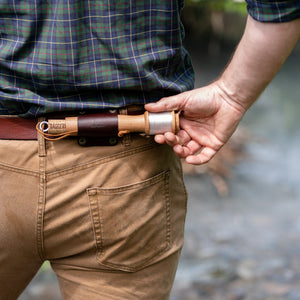Basics of a Backpacking First Aid Kit
When we started the Daggerfish Gear Co, we set out to make products to help people feel calm and confident in the outdoors. Feeling comfortable in the wilderness is the key to enjoying it, but it can be hard to relax if you’re worried about getting hurt.
There’s no doubt that a wilderness first aid kit is an essential piece of gear to have with you in the backcountry. While we don’t make medical kits ourselves, we do specialize in making light and functional outdoor gear, and we can use that same philosophy to provide you with a checklist of items that you should consider for your backpacking first aid kit.
A Basic First Aid Kit for Camping
Wilderness injuries are - most often - little more than scrapes and bruises. The problem with these injuries is not that you will die, but that you’ll be uncomfortable or struggle to complete your trip. Small cuts, scrapes, burns, blisters and joint injuries all fall into this category, as do minor allergic reactions and stomach problems. To handle these kinds of ailments, here’s the basics of what you’ll need:
Bandages
- Band aids (10 large)
- Finger and knuckle band aids (3 of each)
- Medical tape (1 roll)
- Blister pads (6)
- Gauze pad/Sterile bandage (1 large)
- Butterfly bandage (2)
- Elastic bandage (1)
- Alcohol pads (3)
Medication
- 1 tube antibacterial ointment
- 1 tube anti-itch cream
- 1 tube burn cream
- Antihistamine pills (10 pills)
- Pain reliever (ibuprofen, acetaminophen, or aspirin) (20 pills)
- Antacid (10 tablets)
- Loperamide (Anti-Diarrheal medicine) (5 pills)
Other Camping First Aid Items
- Tweezers and/or tick remover
All together, this entire kit should fit into a space about as big as a sandwich bag, and will cover 99% the medical issues you’re likely to encounter on a weekend backpacking trip. Whatever you use up on your trip, replace when you get home, and replenish with fresh items at the start of camping season each year.
A basic first aid kit like this will help keep you comfortable and mobile under most conditions. But here’s the thing: if you’re on a weekend trip, and you can’t treat your injury with what’s in this kit, you need to evacuate. No argument - get out of the woods and go to a doctor as soon as possible. Which leads us to two other essential pieces of first-aid advice:
Bring a Cell Phone

We often go to the wilderness to escape from modern technology, and I don’t advocate keeping your phone powered on the entire time you’re in the woods. But a cell phone is an invaluable piece of emergency equipment, one that may be able to put you in contact with emergency services faster than you can get to them yourself.
Though cell service is increasingly accessible in the woods, getting a signal isn’t a sure bet. Because of that, the old ways are still often the best:
Have An Itinerary and Share It With Family & Friends

Letting others know where you’re going and when you’re coming back is the most valuable thing you can do before heading out into the wilderness, especially if you’re going alone.
Write down, in an email or a text message, what wilderness area you’ll be in, what trail you’ll be on, where you plan to park, and when you plan to return, and send it to someone you trust. Let them know you’ll contact them once you’re back from your trip, and tell them who to call if they don’t hear from you.
If you do get sick or injured so badly that you can’t make it back to civilization, sharing this information beforehand will vastly increase the chance that search and rescue teams can find you.
More First Aid Kit Options for Longer Backpacking Trips
When taking a longer trip, where you’re more than a few hours from civilization, you’ll bear greater responsibility for taking care of yourself and others in true emergency situations. In those cases, you should increase your first aid equipment to include things like
- Blood stopping gauze
- Triangular bandage
- CPR mask
- SAM Splint
- Instant cold pack
- Medical waste bag
- Nitrile medical glove
- Heat-reflecting blanket
- Epipen
This list isn’t comprehensive, and will vary depending on your destination, activities, and the condition of people in your group. But no matter where you’re going and what you have with you, the most valuable thing in your first aid kit is your mind.
Learning how to prevent injuries, recognize the signs of potentially serious illness, improvise with what’s around you, and keep calm while doing so are the real keys to dealing with wilderness medical emergencies.
To learn these skills, look for a wilderness first aid course offered in your area. Organizations like NOLS, SOLO, and even the Red Cross offer courses, and colleges or outdoor clubs often host courses like these. Here are some links to get you started:
- https://www.wildmed.com/wilderness-medical-courses/
- https://soloschools.com/training-information/
- https://www.nols.edu/en/coursefinder/courses/wilderness-first-aid-WFA/
- https://www.redcross.org/take-a-class/cpr/wilderness-sports#wilderness-remote-first-aid
Any camping first-aid kit will strike a balance between treating common, minor ailments, and being prepared in the off-chance you’re subject to a life-threatening injury. Ultimately, it’s up to you to assemble a kit that makes you feel comfortable, but knowing that you have it, and that you know how to use it, is one of the keys to calm and confidence in the wilderness.
What do you carry in your first aid kit? If you’ve got a suggestion for something that we missed, email us and let us know, and we’ll include your suggestions in a future version of this article.




















